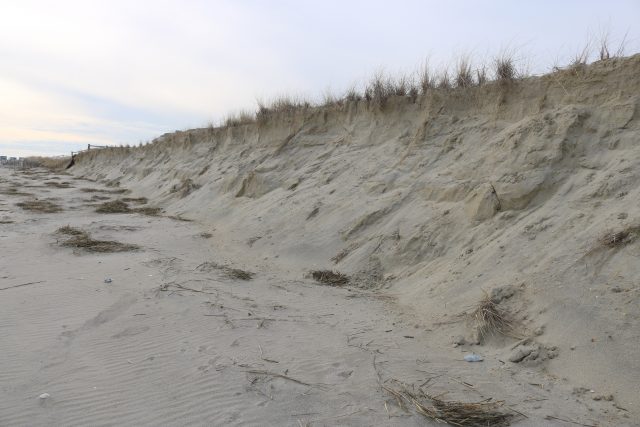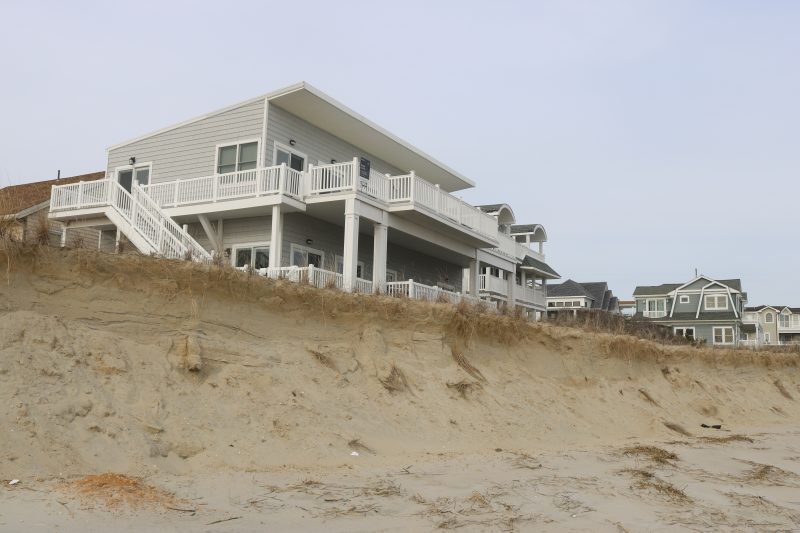
By DONALD WITTKOWSKI
The federal agency that will oversee the replenishment of Sea Isle City’s storm-eroded beaches is expected to seek bids in the spring and will award the contract for the project in June, according to the latest timetable announced by Mayor Leonard Desiderio.
Sea Isle is part of an estimated $30 million beach replenishment project that also includes Strathmere and the southern part of Ocean City.
Storms in late 2022 and the beginning of the new year continue to erode Sea Isle’s protective barrier of dunes as well as the powdery top layer of sand that gives the beaches their attractive appearance.
The U.S. Army Corps of Engineers will restore the depleted beaches with new sand, but it is not yet known exactly when the work will get underway and which one of the three towns will go first in the replenishment project.
Desiderio said the New Jersey Department of Environmental Protection has told Sea Isle that the Army Corps will advertise for bids in April and open them in May. Barring delays, the contract will be awarded in June to the company that will handle the project under the supervision of the Army Corps.
George Savastano, Sea Isle’s business administrator, estimated that the project likely will start sometime at the end of summer. Normally, the contractor is given the discretion to decide which of the three towns will have their beaches replenished first, he explained.
“In my experience, they leave it up to the contractor,” Savastano said in an interview Saturday.
Savastano noted that one crucial factor in deciding which town will go first is the summer nesting season for protected shorebirds. Activity is restricted in the north end of Strathmere and the southern tip of Sea Isle while the birds are nesting, he said.
The nesting area in Sea Isle’s south end, by the Townsends Inlet Bridge, is one of a series of state-supervised refuges along the New Jersey coast designed to protect least terns, American oyster catchers, piping plovers, black skimmers and other shorebirds that are under pressure from predators and loss of habitat.

Meanwhile, surveys are already being done of the eroded shoreline to determine how much new sand will be needed and which beaches will be replenished. Savastano said that the survey results can be adjusted later on if new storms cause even more erosion to the beaches.
Sea Isle wants the beaches restored in the downtown area between 29th and 50th streets and in the south end of the island from generally 75th Street or 80th Street to 94th Street near the Townsends Inlet Bridge, Savastano said.
In the summer of 2020, Sea Isle’s beaches were widened and replenished with more than 750,000 cubic yards of new sand between 28th and 52nd streets and from 74th to 93rd streets in Townsends Inlet.
This year, about a four-block stretch of dunes between 88th and 92nd streets has already been severely damaged by storms. Cliff-like faces about 10 to 15 feet high have been carved in the dunes in this area.
Sea Isle’s beaches and dunes in the downtown area on both sides of John F. Kennedy Boulevard have also suffered storm damage.
In one dramatic case, an oceanfront house at the end of 90th Street appears to be only 15 feet or so from where the dunes have been sheared away by the waves. The single-family home is up for sale, with a list price of $4.5 million.
The city has erected barriers to prevent people from walking on some of the beach pathways in Townsends Inlet and getting too close to the dune drop-offs.
Savastano said the city is prepared to use a process known as “sand harvesting” to patch up the depleted dunes in the vicinity of 90th Street and other hard-hit areas if needed.
“At this point, we’ll keep an eye on it,” he said of the house near the edge of the dunes on 90th Street.

Sand harvesting is a short-term way to restore the damaged dunes. Going about a foot deep, work crews scrape sand from the water’s edge at low tide and push it up to the dunes using bulldozers or earthmovers. The sand removed from the water’s edge is then naturally filled in by the tides.
Savastano said the city is reluctant to begin sand harvesting operations in the middle of winter. The likelihood of more winter storms would mean the sand could be swept away shortly after it is placed on the dunes, he pointed out.
Most likely, the city will wait until mid-April to begin sand harvesting, Savastano said.
The city will continue to monitor the shoreline and make certain that the beach entrances are safe and passable, Desiderio said.
“In the meantime, please know that Public Works will do everything possible to ensure all beaches are in the best shape possible for the coming season. We’ve been through this before, and I have full confidence that our beaches will be ready as always come Memorial Day weekend,” Desiderio said in a statement.







